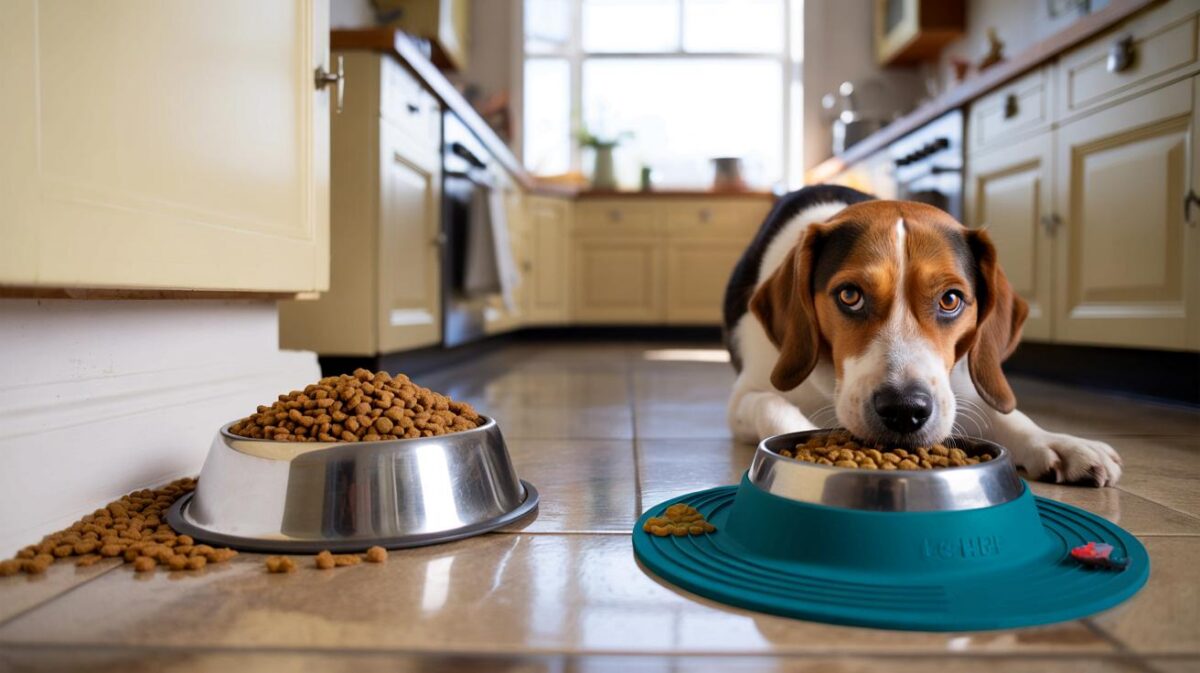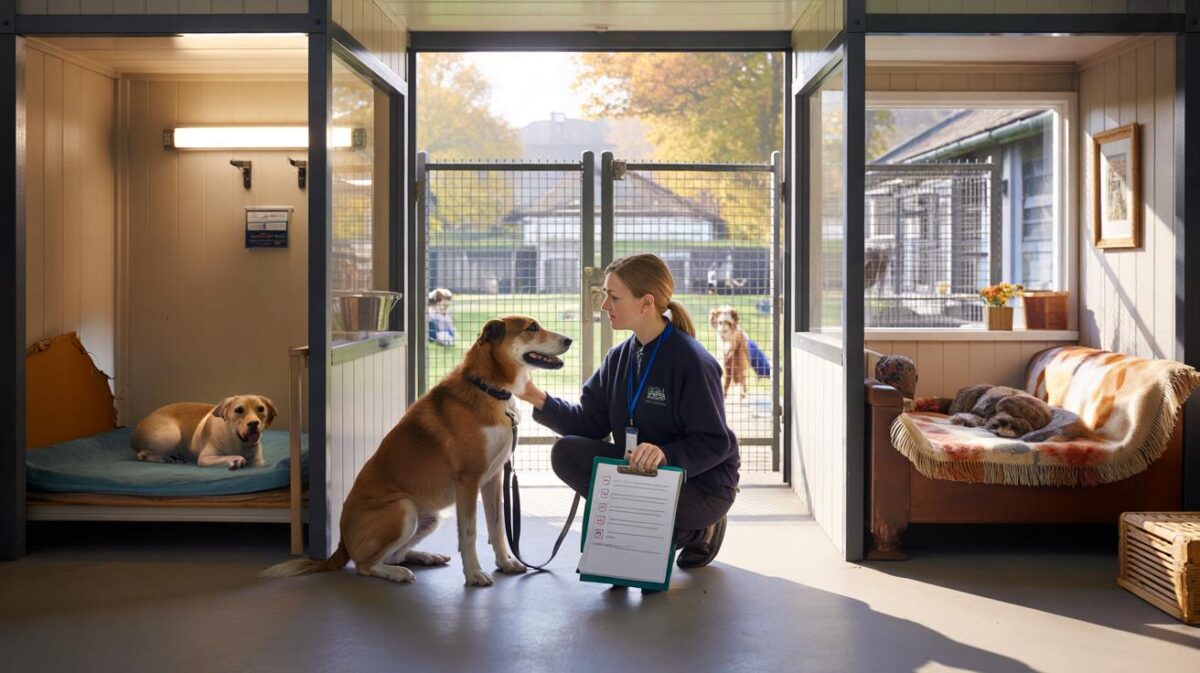Small tweaks now prevent big shocks later.
The shift to cooler evenings brings fresh hazards for owners and dogs alike. Leads snag. Cars appear from the dark. Nervous moments escalate fast. Three everyday habits drive most near-misses on pavements and paths. Change them, and your walks feel calmer, safer and easier on your wallet.
Why autumn walks get risky fast
Traffic grows at the school run. Cyclists cut through parks. Wet leaves hide glass and dropped food. Many dogs return to routine after summer, full of energy but low on focus. That mix breeds errors. A long lead, a loose harness or missed stress signs are enough to create a scare or an injury.
More control does not mean less freedom. It means the right freedom, at the right moment, with clear choices.
Habit 1: the over-long lead
What goes wrong when the lead runs long
Extendable leads and long lines tempt us. Dogs charge ahead. Owners lag. In town, that length multiplies risk. A dog can step into the road in a second. He can reach a reactive dog before you notice. He can swallow a discarded kebab bone before you blink. On narrow paths, the line can trip a runner or tangle a pushchair.
A simple change helps. In busy streets, keep to roughly 1.5–2 metres. That allows sniffing, yet gives you instant response. In open fields, a longer line works if you stay alert. Use a harness, not a collar, with long lines to protect the neck. Wear gloves to avoid rope burn.
Think “J-shaped slack”. If the lead hangs in a gentle J for two steps, you have the right distance and pace.
How to fix it in seven days
- Pick a fixed lead between 1.5 and 2 metres for pavements and shops.
- Teach a stop-start rule: if the lead goes tight, stop; when it slackens, move again.
- Reward “check-ins”: every glance back earns a small treat or praise.
- Practise near low distractions first: a quiet street, then a busier corner.
- Save long lines for open areas. Clip to a harness and keep the line behind you.
Habit 2: poor fit and the wrong kit
Fast fit checks that prevent drama
Loose harnesses slip. Tight ones chafe. Collars pull on the throat when dogs lunge. A better fit changes behaviour because movement turns painless and predictable. Aim for two flat fingers under each strap. The front should sit clear of the throat. A Y-shaped front avoids pressure on the shoulders. Check for rubbing behind the front legs and across the chest.
Adjust across the seasons. Coats thicken, weight shifts and straps loosen. Add visibility now as well. Reflective trim and a small chest light help drivers spot you earlier, especially at dusk and on rainy mornings.
| Equipment | Best use | Advantages | Watch-outs |
|---|---|---|---|
| Flat collar | ID tag, short calm walks | Simple, legal ID point | Pressure on neck if pulling; not for long lines |
| Y-front harness (back clip) | Everyday walks, long lines | Even pressure, shoulder freedom | Needs regular fit checks for rubbing and slippage |
| Y-front harness (front clip) | Training loose-lead skills | Helps reduce pulling angles | Can twist if poorly fitted or used with tension |
| Headcollar | Strong pullers with guidance | More steering, less pulling force | Needs careful introduction; never jerk |
When a collar still makes sense
Dogs in the UK must carry owner details on an ID tag. A collar suits that job. For lead walking, a well-fitted harness usually protects the neck and gives clearer handling. Mix both: collar for ID, harness for control. If your dog chews straps, pick webbing with tight weave and metal hardware, and supervise early walks while you build the habit.
Habit 3: ignoring stress signals
Subtle signs you might miss
Most blow-ups start small. Many dogs show low-level stress long before barking or lunging. Look for quick tongue flicks, repeated yawns, air sniffing with stiff posture, ears tucking back, sudden shake-offs, a tight closed mouth, or wide eyes with the whites showing. Those signals mean “I’m unsure” or “give me space”.
Noise and crowds increase those signals in autumn. Fireworks season looms. Cyclists without lights appear late in the day. Children return en masse to playgrounds and paths. A dog that coped in summer now struggles on the same route.
Distance is your friend. Space before advice. Step away first, then teach skills in calm moments.
Calming tactics that work on the street
- Create space early: cross the road or arc around the trigger by three metres.
- Lower your body and speak softly. Slow breaths help your dog regulate.
- Feed the ground: scatter a few treats to shift focus and promote sniffing.
- Use “pattern games”: two steps, treat; two steps, treat. Rhythm beats chaos.
- Offer choice: let your dog sniff a tree or watch from a distance for 20 seconds.
Autumn hotspots: where trouble starts and how to dodge it
Specific places and moments create clusters of incidents. You can plan around them.
- School gates, 08:15–09:00 and 15:00–16:00: switch to a shorter route or walk earlier.
- Canal towpaths at dusk: fit a chest light and keep lead short to avoid bikes.
- Leaf piles near kerbs: steer clear; glass, mould and sharp sticks hide inside.
- Park bins and benches: teach a “leave it” cue and shorten the lead three metres before.
- Firework evenings: build a toilet break before dark; add white noise at home afterwards.
Money and law: the quiet reasons to act now
Out-of-control moments can bring fines and claims. A dog that runs into the road risks injury and liability. Many insurers report higher claims in darker months for lead tangles, swallowed foreign objects and traffic scares. Average treatment for foreign body ingestion often runs into hundreds of pounds, with bills near £900 not rare. Reflective gear costs a fraction of that, and a snug harness helps avoid the lunge that ends in a clinic visit.
Keep ID tags readable. Microchip details must be current. Some councils step up patrols in busy parks at this time of year. Clear control and a tidy lead go a long way when tensions rise between owners.
A one-week reset plan you can start tonight
Day-by-day, 10 minutes at a time
- Day 1: switch to a 1.5–2 m lead. Walk a quiet block. Reward every check-in.
- Day 2: fit-check the harness with the two-finger rule. Add a chest light.
- Day 3: rehearse stop-start in the hallway for five minutes, then outside for five.
- Day 4: teach “leave it” with low-value scraps on the pavement and quick rewards.
- Day 5: practise arcing around a friend at three metres. Keep the J-shaped slack.
- Day 6: add a five-minute sniff walk. You set the zone; your dog sets the pace.
- Day 7: take the open park route with a long line and harness. Gloves on, eyes up.
Extra gains: visibility, recall and scavenger safety
Run a quick visibility check before dusk. Stand ten metres away and crouch. If you lose sight of your dog’s chest in the gloom, fit a light or reflective tab. For recall, pick one cue. Use it once, pay well, and never repeat in a row. A long line prevents rehearsals of “I can’t hear you”. For dogs that hoover food, introduce a basket muzzle indoors with treats. Pair it with a harness and long line in high-risk areas so scavenging never pays.
What to do when plans fail
Bad days happen. Cut the route short. Shift to a car park lap or a quiet cul-de-sac. Play food search games at home or offer a chew to meet sniffing and licking needs safely. Log triggers on your phone with time and place. Patterns appear within a week, and you can feed that map back into your routes and rehearsal windows.








